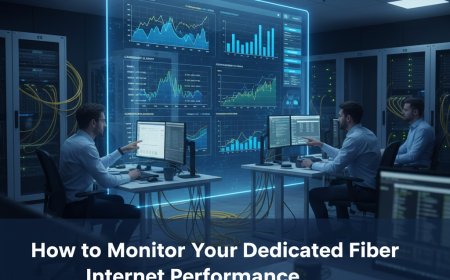Protecting Your IT Hardware with Reliable Surge Suppressors
Learn how surge suppressors safeguard IT hardware and computer hardware from electrical surges. Discover benefits, types, and tips for choosing the best surge protection solution.
Introduction
In today’s technology-driven world, IT hardware and computer hardware form the backbone of modern business operations. From personal desktops to enterprise-level data centers, the continuous performance of these systems depends heavily on stable electrical power. However, electrical surges—sudden spikes in voltage—pose a silent yet serious threat to hardware performance and longevity. This is where surge suppressors come into play.
A surge suppressor, also known as a surge protector, is an essential device designed to protect electrical equipment from unexpected voltage spikes. By redirecting excess electricity safely to the ground, it prevents potential damage to sensitive components within your IT setup. This comprehensive guide explores the importance, functionality, and benefits of surge suppressors in maintaining reliable power protection for modern computer systems.
Understanding Surge Suppressors
What Is a Surge Suppressor?
A surge suppressor is a protective device that limits voltage spikes by blocking or diverting excess electrical current. It acts as a shield between your equipment and the power source, ensuring that your IT hardware receives a stable, consistent voltage supply. Unlike standard power strips, which only distribute electricity, surge suppressors include internal components such as metal oxide varistors (MOVs) that absorb sudden voltage surges.
When lightning strikes, utility issues, or internal wiring faults cause voltage spikes, the MOV in a surge suppressor reacts instantly—absorbing the excess current and preventing it from reaching your computer hardware.
Why Are Power Surges Dangerous?
Electrical surges can occur at any time and are often unpredictable. They might last only microseconds, but their impact can be devastating. Power surges can burn circuit boards, corrupt stored data, and shorten the lifespan of electronic devices.
For example, imagine a network server that controls business-critical applications or an external storage drive containing important data. A single surge event can render such systems inoperable. Over time, even small, repetitive surges can degrade components, leading to performance instability.
The Role of Surge Suppressors in IT Hardware Protection
In IT environments, surge suppressors serve as the first line of defense against unpredictable voltage fluctuations. Servers, routers, modems, and desktops rely on a steady power flow to function optimally. A surge suppressor ensures that any power irregularity is neutralized before it reaches these sensitive devices, helping organizations avoid downtime, data loss, and repair costs.
How Surge Suppressors Work
Surge suppressors operate on a simple principle: detecting excessive voltage and diverting it away from connected devices. Here’s a breakdown of how they function:
-
Voltage Detection: The suppressor continuously monitors the flow of electricity from the outlet.
-
Dissipation: When voltage exceeds a safe threshold (usually around 120 volts in standard circuits), the MOV component diverts the excess energy.
-
Grounding: The extra current is sent safely into the ground wire, protecting connected devices.
-
Reset or Absorption: After the surge, the MOV resets, ready to handle future surges.
Modern surge suppressors also come with indicator lights, noise filters, and automatic shutdown features that further enhance equipment safety and reliability.
Types of Surge Suppressors
Not all surge suppressors are created equal. The right choice depends on your specific environment and equipment. Let’s explore the main types available today:
1. Plug-in Surge Suppressors
These are the most common and user-friendly types. Ideal for home and office use, plug-in suppressors protect computer hardware like desktops, monitors, and printers. They often include multiple outlets and USB ports, allowing you to safeguard several devices at once.
2. Whole-House Surge Suppressors
Installed at the main electrical panel, whole-house units protect every connected device in your home or office. These are particularly beneficial in areas prone to lightning or power fluctuations.
3. Rack-Mount Surge Suppressors
For data centers and IT hardware rooms, rack-mounted suppressors offer centralized protection for servers, routers, and network switches. They are designed for high-capacity environments where reliability is non-negotiable.
4. Uninterruptible Power Supplies (UPS) with Surge Protection
Many UPS systems include built-in surge suppressors. These devices not only provide backup power during outages but also filter and stabilize electrical surges—making them a dual-purpose solution for critical IT hardware setups.
The Importance of Surge Suppressors in IT Infrastructure
Safeguarding Expensive Equipment
IT environments often host costly equipment such as servers, switches, and storage arrays. These devices are sensitive to even minor voltage variations. Without a surge suppressor, a single spike can result in permanent damage, leading to substantial replacement costs.
Ensuring Business Continuity
For businesses, downtime means lost productivity and revenue. Surge suppressors help maintain operational continuity by preventing damage that could lead to equipment failure. In industries where uptime is vital—like finance, healthcare, and e-commerce—such protection is invaluable.
Protecting Data Integrity
Data is the lifeblood of modern business. Voltage surges can corrupt files, disrupt data transfers, and even cause system crashes. Surge suppressors ensure that computer hardware operates within safe voltage limits, preserving data accuracy and system reliability.
Extending Equipment Lifespan
Even small surges can gradually degrade electronic components over time. Consistent exposure to minor spikes shortens hardware life expectancy. By filtering out excess voltage, surge suppressors help maintain device performance and extend overall longevity.
Key Features to Consider When Choosing a Surge Suppressor
Selecting the right surge suppressor requires understanding its specifications and matching them to your setup’s requirements.
1. Joule Rating
The joule rating indicates how much energy a surge suppressor can absorb before failing. Higher joule ratings provide greater protection. For IT hardware, aim for suppressors rated above 2000 joules.
2. Clamping Voltage
This value shows the voltage level at which the suppressor starts diverting excess electricity. Lower clamping voltage (around 330 volts) means better protection for sensitive computer hardware.
3. Response Time
A good surge suppressor reacts almost instantly—typically within nanoseconds—to block harmful surges.
4. Indicator Lights
Modern units feature LED indicators that show protection and grounding status, ensuring your devices are always shielded.
5. Outlet Configuration
Choose a suppressor with enough outlets to cover your current and future hardware needs. Some also include USB ports or network jacks for added versatility.
6. Warranty and Equipment Coverage
Reputable brands offer warranties and even equipment coverage guarantees. This adds extra peace of mind when protecting high-value IT hardware investments.
Common Causes of Power Surges
Understanding the root causes of surges helps in designing better protection strategies.
-
Lightning Strikes: Direct or nearby lightning can introduce massive voltage spikes into your system.
-
Power Grid Switching: Utility maintenance or grid transitions often cause transient surges.
-
Faulty Wiring: Poor grounding or outdated wiring can generate internal surges.
-
High-Powered Equipment: Air conditioners and refrigerators can cause surges when cycling on and off.
-
Power Outages: When electricity is restored after an outage, voltage spikes can occur instantly.
Recognizing these risks highlights why consistent use of surge suppressors is critical to maintaining power stability.
Surge Suppressors vs. Power Strips
It’s a common misconception that all power strips offer surge protection. While power strips merely expand outlet availability, surge suppressors actively protect against voltage spikes. If your device doesn’t specify a joule rating or clamping voltage, it’s likely just a power strip—not a true suppressor.
For professional computer hardware setups, always invest in certified surge suppressors that meet recognized safety standards such as UL 1449.
Surge Suppressors in Data Centers and Enterprise Environments
In enterprise-level operations, downtime caused by electrical surges can translate into thousands of dollars in losses per minute. Data centers host critical servers, networking equipment, and storage systems—all of which require high-level surge protection.
Rack-mounted and whole-facility surge suppressors provide multi-layered defense. They ensure that every device, from power distribution units (PDUs) to servers, receives filtered, regulated electricity. In combination with UPS systems, they form a complete power protection ecosystem for IT hardware infrastructure.
Regular inspection and maintenance of surge protection systems are also essential. Over time, MOV components degrade due to repeated surge absorption. Replacing outdated suppressors ensures consistent performance and avoids hidden vulnerabilities.
The Connection Between Surge Suppressors and Energy Efficiency
While primarily designed for protection, modern surge suppressors also contribute to energy efficiency. By stabilizing voltage and filtering electrical noise, they enable computer hardware to operate more efficiently. Some advanced models include smart circuitry that reduces idle power consumption, helping both home users and businesses lower their energy costs.
Installation Tips for Optimal Protection
Proper installation is key to maximizing surge suppressor performance.
-
Use Dedicated Circuits: Avoid overloading a single circuit with multiple high-powered devices.
-
Maintain Proper Grounding: Always ensure outlets are properly grounded. Poor grounding can render a surge suppressor ineffective.
-
Avoid Daisy-Chaining: Never connect multiple suppressors or power strips together; it increases fire risk and reduces effectiveness.
-
Regularly Inspect Devices: Replace suppressors that have absorbed multiple surges or show signs of wear.
These practices ensure reliable protection for all your connected IT hardware.
Surge Suppressors in the Evolving Tech Landscape
As technology evolves, so does the demand for better electrical protection. Modern computing environments include smart devices, IoT systems, and high-performance servers—all requiring consistent voltage regulation.
Innovations in surge suppression technology now include real-time monitoring, remote management, and integration with smart power systems. Some advanced surge suppressors can even communicate with network management software, allowing administrators to track performance and receive alerts during power anomalies.
This convergence of power protection and smart monitoring enhances the overall resilience of computer hardware and supports sustainable, efficient IT operations.
When to Replace a Surge Suppressor
A common misconception is that surge suppressors last indefinitely. However, every time a suppressor absorbs a surge, its capacity decreases slightly. Over time, the MOVs inside wear out, reducing the unit’s effectiveness.
Most manufacturers recommend replacing surge suppressors every three to five years, or sooner if they experience frequent surges. Always monitor indicator lights—if the “protected” light goes off, it’s time for a replacement. Keeping your surge protection system updated ensures ongoing safety for your IT hardware and computer hardware investments.
Conclusion
In an era where technology powers every aspect of business and daily life, protecting your IT hardware from electrical surges is more than a precaution—it’s a necessity. Surge suppressors serve as a critical defense mechanism, ensuring that your computer hardware operates safely, efficiently, and reliably.
From home offices to enterprise data centers, investing in high-quality surge suppression is a small step with massive benefits. It prevents data loss, extends hardware lifespan, and supports uninterrupted productivity. Whether you’re managing a personal workstation or an entire IT network, surge suppressors are your first and best line of defense against unpredictable electrical threats.
Ultimately, a well-chosen surge suppressor is not just an accessory—it’s an insurance policy for your technology, safeguarding your systems, data, and peace of mind in a world powered by electricity.
























